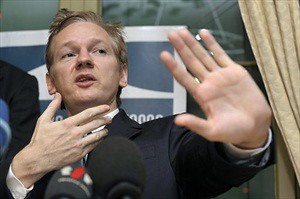
Julian Assange, founder of WikiLeaks, was arrested and denied bail in the United Kingdom on Dec. 7, 2010. The Australian Foreign Minister has blamed the U.S. for the leak of information on diplomatic and military matters., a photo by Pan-African News Wire File Photos on Flickr.
WikiLeaks publishes full cache of unredacted cables
Former media partners condemn WikiLeaks' decision to make public documents identifying activists and whistleblowers
James Ball guardian.co.uk,
Friday 2 September 2011 12.55 BST
WikiLeaks has published its full archive, including diplomatic cables marked by the US to indicate sources could be in danger.
WikiLeaks has published its full archive of 251,000 secret US diplomatic cables, without redactions, potentially exposing thousands of individuals named in the documents to detention, harm or putting their lives in danger.
The move has been strongly condemned by the five previous media partners – the Guardian, New York Times, El Pais, Der Spiegel and Le Monde – who have worked with WikiLeaks publishing carefully selected and redacted documents.
"We deplore the decision of WikiLeaks to publish the unredacted state department cables, which may put sources at risk," the organisations said in a joint statement.
"Our previous dealings with WikiLeaks were on the clear basis that we would only publish cables which had been subjected to a thorough joint editing and clearance process. We will continue to defend our previous collaborative publishing endeavour. We cannot defend the needless publication of the complete data – indeed, we are united in condemning it.
"The decision to publish by Julian Assange was his, and his alone."
Diplomats, governments, human rights charities and media organisations had urged WikiLeaks's founder, Assange, not to publish the full cache of cables without careful source protection.
The newly published archive contains more than 1,000 cables identifying individual activists; several thousand labelled with a tag used by the US to mark sources it believes could be placed in danger; and more than 150 specifically mentioning whistleblowers.
The cables also contain references to people persecuted by their governments, victims of sex offences, and locations of sensitive government installations and infrastructure.
WikiLeaks has published its full archive in an easily accessible and searchable manner, the first time the content has been made widely available to those without sophisticated technical skills.
It conducted a poll of its Twitter followers to decide whether to publish the documents, which it initially said was running at "100 to one" in favour of publishing. WikiLeaks did not disclose the final tallies, nor how many individuals responded to its poll.
Reporters Without Borders, a press freedom group which had been maintaining a backup version of the WikiLeaks site, revoked its support for the whistleblowing site in the wake of the decision.
"Some of the new cables have reportedly not been redacted and show the names of informants in various countries, including Israel, Jordan, Iran and Afghanistan," it said in a statement. "While it has not been demonstrated that lives have so far been put in danger by these revelations, the repercussions they could have for informants, such as dismissal, physical attacks and other reprisals, cannot be neglected."
The whistleblowing website began releasing the cables in December 2010, in conjunction with five media organisations including the Guardian. The mainstream news organisations carefully selected cables and before publication removed any information which could lead to sensitive sources being identified.
WikiLeaks claimed its disclosure was prompted after conflicts between Assange and former WikiLeaks associates led to one highlighting an error made months before. When passing the documents to the Guardian, Assange created a temporary web server and placed an encrypted file containing the documents on it. The Guardian was led to believe this was a temporary file and the server would be taken offline after a period of hours.
However, former WikiLeaks staff member Daniel Domscheit-Berg, who parted acrimoniously with WikiLeaks, said instead of following standard security precautions and creating a temporary folder, Assange instead re-used WikiLeaks's "master password". This password was then unwittingly placed in the Guardian's book on the embassy cables, which was published in February 2011.
Separately, a WikiLeaks activist had placed the encrypted files on BitTorrent, a peer-to-peer file sharing network, in the hours before Julian Assange was imprisoned pending extradition proceedings in December 2010, as a form of insurance for the site. Fewer than five people knew of the existence of the site.
As former activists' disillusionment with WikiLeaks grew, one told German magazine Freitag about the link between the publicly available password and files in an attempt to highlight sloppy security at WikiLeaks. The magazine published the story with no information to identify the password or files.
WikiLeaks then published a series of increasingly detailed tweets giving clues about where the password might be found as part of its attempts to deny security failings on its own part. These are believed to have led a small group of internet users to find the files, which were published in a difficult-to-access format requiring significant technical skill, on rival leak site Cryptome.
Domscheit-Berg, often referred to as Assange's former deputy at WikiLeaks, condemned the password reuse. "The file was never supposed to be shared with anyone at all," he said. "To get a copy you would usually make a new copy with a new password. He [Assange] was too lazy to create something new."
No comments:
Post a Comment